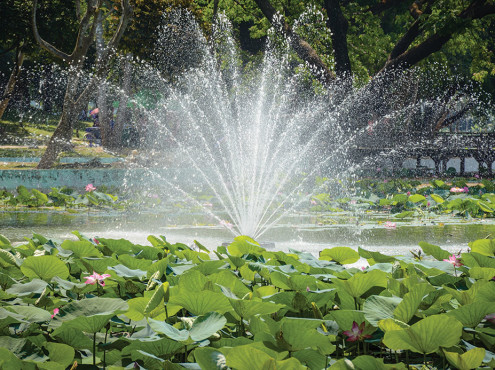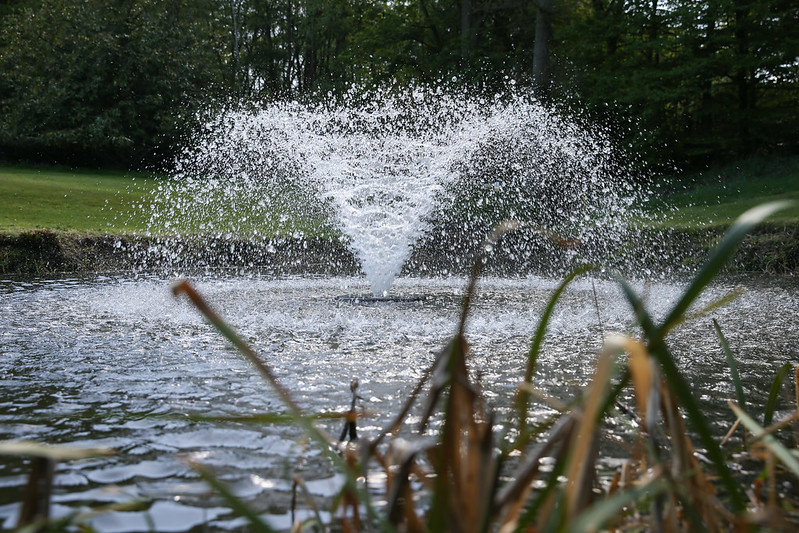Pond dynamics and summer
Everything to consider when buying a new aeration system
As the seasons change so do pond and lake dynamics. During summer months, in particular, biological activity is heavily impacted.
It’s important to understand how seasonal changes can affect life as a greenkeeper, course manager, and property management professionals, and how to prevent water quality issues during them.

Why is it important to aerate ponds and lakes in the summer?
In summer, expect nutrient loading in ponds and lakes as leaves, water fowl, fish waste, dead and dying aquatic plants like algae sink to the bottom. This then increases bacterial digestion rates, nutrient levels, and biological oxygen demand, which throws a pond out of balance.
A sludge bed or ‘aquatic compost’ pile begins to form at the bottom of the pond or lake. If not dealt with, this sludge is guaranteed to cause future headaches.
As such, summer conditions create a need for supplemental aeration helping decomposition occur at its maximum rate. Aquatic plants will change significantly in summer, too, thanks to warmer water temperatures, higher nutrient levels, and increased light exposure, creating a higher demand for oxygen.
Aeration systems, then, give ponds and lakes the extra boost they need to remain healthy and keep water quality high during the summer.
Where to begin with aeration?
Whether looking for a water quality management solution or simply aesthetic enhancement, there are several types of pond and lake aerators to consider:
- Surface spray (floating) aerators
- Air diffused systems
- Horizontal aspirators or mixers
Each type has unique differences as well as efficiencies, which may be utilised in a variety of ways to achieve the maximum benefit for each unique water body.
How to select the right aeration system for your course
When selecting and installing your new aeration system, it’s important to consider the size, shape, and depth of the pond – as this will dictate the type or combination of aerators that should be used.
Keep in mind that when water quality management is an objective the recommended size is 2hp per surface acre, meaning:
- Surface spray aeration systems are best for ponds less than 15ft (4.57m) deep, or whenever a spray fountain effect is desired.
- Diffused aeration systems are best for ponds 15ft (4.57m) and greater in depth, as well as when no surface spray is desired.
- Mixers and aspirators are best for ponds less than 9ft (2.74m) deep where lateral movement is dictated, or no surface spray is desired.
Always check bubble size when selecting a new aerator
As a rule of thumb, the smaller the bubble, the more effective the aeration system.
This is primarily due to the fact that smaller bubbles tend to stay in the water longer, creating a greater residual effect and spreading across a greater surface area of the water while rising to the lake or pond water surface.
Increase dissolved oxygen levels with smaller bubbles
Larger bubbles tend to rise to the surface quicker and, as opposed to smaller bubbles, leave less time for oxygen to dissolve in the water. Dissolved oxygen is important for overall lake and pond health.
The motion of bubbles to the pond surface has the capacity to move an enormous amount of water, estimated between 5000-8000 pounds per hour.
Consider the depth of your water body
Water circulation will increase as the depth increases, which means the greater the depth of your pond or lake, the better the water will be mixed and aerated.
Scientists have determined that the peak efficiency depth is 15ft and studies indicate that for every three foot decrease in depth, the relative efficiency of an aerator will drop by about 50 percent.
Make sure to meet the right electrical requirements
Having operating electricity is necessary before installation and start-up of aeration systems, and a certified electrician may also be required during the installation.
In order to install and operate Otterbine systems efficiently you need to keep a few things in mind:
- What type of power is available, single phase or three phase?
- How much power is available?
- How close is the pond or lake to the power source?
- Is anything else using that power source, excluding irrigation or lighting?
It’s important to make sure you review what electrical codes should be followed during the installation process and trenching required (conduit vs. direct burial), so they can be easily accessed in the future.
If that sounds complicated, then don’t worry – Otterbine’s factory trained distributors are available to provide free site analysis and assistance with deciding on the best lake aeration option for your course.

How to install your new aeration system
There are two ways of securing most aeration systems into position: anchoring to the pond bottom and mooring to the pond’s edges, either above or beneath the waterline.
If you’re planning to ‘do-it-yourself’, you’ll need to consider the method of securing and the quality of materials used, as these may impact safety, security, and ease of service.
What tools and materials are needed?
Make sure you have a shovel to dig a trench for the cable, conduit, or stainless steel cable, as well as nylon rope or cinder blocks when anchoring and rebar or duckbill anchors if mooring.
Diffused air systems do not require anchoring or mooring, but a boat is often required during installation.
Intensive landscaping around the pond such as retaining walls, waterfalls, and planting beds could affect installation, in addition to the future access for service or maintenance – further coordination may be needed between the aeration installer or irrigation contractor in these circumstances.
What’s the difference between single phase and three phase powered aerators?
Although water quality management, aesthetics, pricing, product quality, and warranty are primary factors to consider when purchasing a new aeration system, power is key and often overlooked.
There are two types of power when it comes to aerators – single phase and three phase, with each having its own advantages. Let’s break them down.
The benefits of a single phase powered aerator
Single phase is more widely available in residential settings and is less expensive to purchase than three phase power units.
Commonly called ‘residential voltage’, single phase power relies on two-wire conductors to distribute power to create a single sine wave (low voltage).
Single phase, in summary:
- Motors are driven by pulsating torque (like a pulsating shower head)
- Motors require capacitors and/or start switches that need to be monitored
- Experiences more interruptions in electrical flow
- Motors have a shorter lifespan
The benefits of a three phase powered aerator
Three phase power is most commonly used at commercial/professional sites and is recommended for larger ponds and lakes.
These units are less expensive to operate than single phase power units and come in 3hp or higher units.
Three phase power relies on three coils mounted on the rotor at 120 degree intervals, which produce three sine wave voltages (high voltage), universally used for power distribution.
Why we recommend considering a diffused air system for ponds and lakes
A simple solution to keep ponds and lakes clean and clear without the use of chemicals and the need of motorised mechanisms is a diffused air system.
Fine-bubble diffused air systems first became popular in the 1970s and have since been recognised for their effectiveness.
Great for deeper ponds and lakes
While it has been proven that in less than six feet of water diffused air systems are not as effective as other types of aerators, research has shown that if placed accurately diffused aerators can be very effective in maintaining a deep body of water.
They can also be beneficial in ridding a pond or lake from symptoms of oxygen depletion, such as odour, discolouration, excessive algae, and fish kills.
Simple and effective design
Each system comes equipped with three main components: an air compressor, an air hose, and a diffuser. The diffuser is placed on the floor of the pond after being attached to the air hose, which is fixed to the air compressor. The air compressor is located on-shore and also houses the electric motor, making it easy to access.
Powerful compressor system
The compressor pushes large amounts of air through the hose and as the compressed air is squeezed through the diffuser, thousands of air bubbles scramble at an approximate rate of 1ft (30cm) per second from the bottom of the lake to the surface.
In this instance, bubbles not only transfer lake water from the bottom to the top, circulating and de-stratifying the pond, but they also replenish the oxygen supply throughout the water, helping aquatic plants.
This allows for aerobic bacteria to rid the pond of noxious gases such as hydrogen sulphide and ammonia. Moreover, on the surface of the lake or pond, bubbles create a rippling effect which deflects sunlight from reaching the bottom of the pond, deterring algae growth.
As with any aerator, efficiency depends on a few factors. In this case, the most influential are the size of the bubbles being dispersed and the depth of the lake, which should be 4.5m deep or greater.
A professional can help recommend the best setup for your pond or lake
Proper placement of the diffuser is also relevant to the effectiveness of aeration – but this matter is very site-specific.
Most ponds have varying depths and many are designed with what are called ‘dead spots’, so we always recommend a professional examine your site to determine where best to place the diffuser so it will be both efficient and effective.
We have dedicated experts on good management of lakes and ponds who are happy to run through water quality symptoms and best practice with you.
If this is of interest to you, or if you have any other queries, then do get in touch with us at Reesink Hydro-Scapes on 01480 226948.